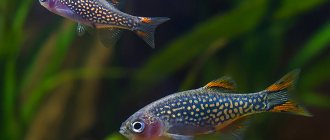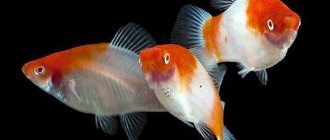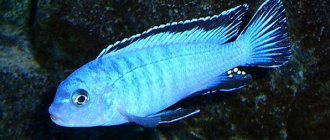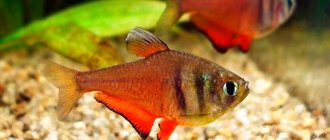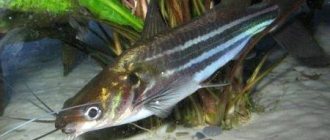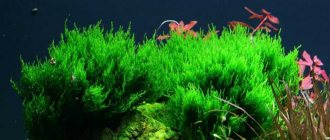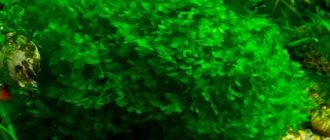In nature, representatives of the species Trigonostigma espei are divided into two main populations. One of them is located in the southwest of Thailand, the other in the southeast part of the country along the border with Cambodia.
The Rasbora espei is known to range as far as the Prek Tuk Sap River basin near the coastal city of Sihanoukville in southwestern Cambodia. There is evidence that the fish was also seen in Laos, although it may have simply been confused with another species. Recently, a population was discovered near Phu Quoc Island in Vietnam.
Range and Habitat
Cuneiform rasboras (Genus Trigonostigma) distribution areas.
This genus is widespread in water bodies of South and Southeast Asia, Indonesia and the Philippines.
Wedge-spotted rasboras (Genus Trigonostigma) habitats, biotope
Representatives of the genus are mainly schooling fish that stay in the upper layers of stagnant and slow-flowing reservoirs.
Galaxy
The Rasbora galaxy is a relatively new species and is distinguished from other members of its genus by its unique iridescent color. The galaxy has other names: “fireworks”, “margaritata”, star rasbora.”
The galaxy has a tiny size, which is why it is nicknamed microrasbora. The body is variegated, can vary from blue-green to blue-steel, and is decorated with multi-colored spots. Rasbora galaxy reaches 2 cm in size. Males are gray-black with light specks, and have bright red longitudinal stripes on their fins. Females are much more modest, their fins have transparent red scorch marks.
Galaxy
Content
The fish are usually kept in numbers of 30 and their life lasts 2 years. The habits of the galaxy resemble guppy fish. The volume of the aquarium for one couple is 5 liters, water temperature 25-27°C, acidity 6.5-8, medium hardness. The galaxy loves a lot of plant thickets and floating plants, in which it will be easy for her to hide.
The galaxy feeds on algae, small live food: daphnia, grindal, nematodes, cut bloodworms and dry food.
Breeding
Rasbor breeding is not difficult. Due to their gregarious nature, males compete all the time. A female ready for breeding is recognized by her rounded belly and clear dark spots on her abdomen. The female lays up to 30 eggs on tufts of moss or roots of floating plants. The fry have dark pigmentation. The Rasbora galaxy acquires adult coloration at the age of 3 months.
Compatibility
Rasbora galaxia gets along well with tetras, rasboras espei, characins and rainbows. Sharing with larger, more active fish can lead to shyness or distress.
Galaxy gets along well with any small peaceful fish; sometimes males can only chase other males with brighter colors.
Return to content
Description
These fish are easily identified by their high, laterally flattened body and a dark triangular spot that gradually narrows in the back of the body and extends to the base of the caudal fin. The Latin name of the genus is translated as a triangular spot.
Cuneiform rasboras (Genus Trigonostigma) species, description.
The characteristic pattern also gave rise to their English name – harlequin rasboras.
Diseases
Rasbora espei is resistant to tropical fish diseases. If not maintained properly, their immunity may weaken and the fish will become susceptible to disease.
Rasbora can be affected by the following diseases:
- Cold . Develops in fish kept in cold water.
- Fungal infections . They occur when rasbora is kept in cool or untreated water.
- Oodious disease . The disease is accompanied by destruction of the skin on the head of the fish, while the body and gill slits are covered with a golden-yellowish coating.
To prevent diseases it is recommended:
- systematically carry out water changes;
- Clean the aquarium using a filter, removing organic matter and food residues;
- periodically inspect the fish;
- The lighting should not be too bright, as too much light can cause harm to the fish.
Behavior and Compatibility
Wedge-spotted rasboras are gregarious species, and if kept alone in an aquarium, they become shy; moreover, all the splendor of color, especially in males, is revealed only in the presence of individuals of their own species.
Rasbora Hengeli (Trigonostigma hengeli) is a prominent representative of the genus.
Being absolutely peaceful, rasboras are ideal for creating multi-species compositions in an aquarium with other peaceful fish of a similar size.
Compatibility with other types
Rasbora espei is a very peaceful fish, which makes it an ideal inhabitant of aquariums with other species. Since it is not so demanding in terms of the chemical composition of the water, it can be added to various fish that are popular among aquarists. Thus, the rasbora will get along well with other small fish from the carp family, for example, with tetras, pecilopsis, dwarf cyprinids, catfish and loaches. As always, when choosing a suitable group of fish to live together in an aquarium, you need to carefully study the issue, and also take into account the size of the adults.
By nature, the Rasbora Espei is a schooling fish and should really be kept in groups of at least 8-10 individuals. In a school, the fish will not only be less nervous, but also behave more naturally. Also, the color of the males will be brighter, as they will compete with each other for the attention of the female.
Aquarium
The minimum aquarium volume is 10 liters for a couple and 100 liters for a group of 10-15 individuals.
Wedge-shaped rasbora (T. heteromorpha) a popular representative of the genus
Preparing an aquarium for these analyzes does not require much trouble; the soil is preferably fine-grained and dark. In dark colors, it is advisable to maintain the background. Various driftwood, bamboo branches, etc. are appropriate as decorations. It is advisable to fill the peripheral zone with dense thickets of aquatic grasses. The lighting is diffused, moderate; floating plants are used as a light filter.
Water parameters:
Temperature: 23 - 28° C pH: 6.0 - 7.0 Hardness: up to 12° dGH
Effective filtration, regular water changes of the same parameters up to 25% weekly.
Reproduction
For breeding, you should acquire a separate aquarium in which adult sexually mature specimens are placed. The lighting of the spawning tank should be low. A layer of plants or mesh should be placed at the bottom. The fish are fed generously with nutritious food for several weeks. Before spawning, the water is changed by 50% and its temperature is reduced by several degrees . 1-2 pairs of fish are left in the spawning tank.
During spawning, the male guides the female to the back of the wide leaves of plants and performs a courtship dance. The female turns over with her belly up and lays eggs. After this, the fish are removed.
The fry appear after two days. They begin to swim after 7 days. You can use small dry food to feed them.
Breeding
In nature, many species spawn in large groups.
Representatives of this genus also differ in reproductive biology. Unlike other rasboras, which simply scatter their eggs during spawning, wedge-shaped ones glue their eggs to the lower surface of the leaves of aquatic plants.
Wedge-spotted rasboras (Trigonostigma) male and female, pair, differences.
Breeding these fish is an extremely difficult process. The fish reach maturity at 7-10 months, depending on the conditions of detention. Around this time they should be planted for spawning. In an optimal pair, the male should be one month older than the female. 10–12 days before spawning, the spawners (no more than 2 males and 3–4 females) need to be seated and fed generously, preferably with bloodworms. At the same time, the fish will get used to the spawning water, which is somewhat different in its parameters from the aquarium water.
The volume of the spawning tank must be at least 30 liters. Broad-leaved plants, such as Thai fern or cryptocoryne, are a must. Plants for the spawning tank must be thoroughly washed, and the aquarium must be disinfected. It is worth putting a net on the bottom to preserve the eggs. The water level of the spawning tank is no more than 20 cm. The water parameters in the spawning aquarium are as follows: hardness - 4, pH 5.5 -6.5, temperature 26 - 28 ° C. Sudden changes are not allowed. The spawning water should be filtered with peat infusion to the color of green tea. Lighting is preferably diffused. However, sometimes it spawns in bright light.
Rasbora Espei (Trigonostigma espei) is a prominent representative of the genus.
If the conditions created in the spawning area are favorable, the male begins to push the female down, circling above her. The female will soon after this begin to swim above the leaves of the plants, sometimes taking a vertical position upside down. A male will soon join her. It wraps itself around her body, after which the female lays several eggs, which immediately stick to the leaves. Everything is repeated many times. Some of the eggs will still fall to the bottom of the aquarium, under the net. During 1.5–2 hours of spawning, the female can spawn up to 300 eggs.
After spawning, the fish need to be placed back in the aquarium, and the walls of the spawning tank should be darkened. The larvae appear after 36 hours, and the fry are able to swim and feed by the 5th day of life. As a starter feed, you need to use the smallest zooplankton: brine shrimp and daphnia. Since the fry have an excellent appetite, they need to be fed several times a day. Then special dry food can be added to their diet. Grown-up fry can eat granulated food, coretra, enchytraea, small bloodworms, cyclops, daphnia, and brine shrimp. Rasbora fry grow very quickly.
Maintenance and care
Caring for the fish is easy, as their natural habitat often resembles a rather run-down aquarium with yellow water. However, this state of water should not be allowed; unlike nature, the reservoir is limited and pathogenic microorganisms can develop under such conditions. The water should be soft and slightly acidic, which should be renewed by half once a month. A powerful filtration system is not required; a simple filter with a sponge as a filter material is sufficient. Fish prefer the upper and middle layers of water, so the bottom can be planted with leafy plants, dense thickets of which should be placed along the side walls of the aquarium. The presence of floating plants will provide the fish with a sense of security and will also dim the lighting. Dark soil helps to increase the brightness of the color of fish; its composition does not matter, the main thing is that there are no sharp edges on stones or other designs. Bog wood is recommended, thanks to it tannins get into the water and the composition of the water becomes as close as possible to natural conditions.
Rasbora Heteromorpha or Wedge-shaped (Trigonostigma heteromorpha)
Rasbora Heteromorpha (T. heteromorpha) representative of the genus, appearance.
A long-time favorite in home aquariums, its history dates back over a hundred years. For most aquarists, the name rasbora is associated with this species, although, as we already know, it is the most atypical representative of this group. This is the largest (up to 5 cm) and tall-bodied of all cuneiform rasboras. The body color is pinkish, a black wedge-shaped spot starting from the middle of the body, wide, evenly tapering towards the tail. In males it is clearly defined, in females it is blurred, with a rounded lower apex. In addition, males are distinguished by a brighter red dorsal fin. The species is widespread in Thailand, Malaysia, Sumatra and Kalimantan.
Nutrition rasbora
The fish described is a predator. Under natural conditions, it feeds on plankton and insect larvae. But when kept at home, she is not particularly picky and, in essence, eats anything.
This is the nature of rasbora . Breeding fish, however, requires the preparation of a certain diet. In this case, it is better to base your diet on good quality dry granulated food from reputable manufacturers.
Brigitte's rasbora in the photo
Suitable for live food: consisting of mosquito larvae, bloodworms or coretra; a type of worm - enchitrae; small crustaceans - brine shrimp, cyclops or daphnia. When eating, fish behave extremely funny and watching them is a real pleasure.
They quickly swim up to the feeder and, having captured pieces of tasty prey, strive to dive to a certain depth to enjoy the meal. If the fish are well fed, they reproduce well, and during such periods their color becomes brighter.
During spawning, rasboras need good quality food, that is, exclusively live food, supplemented with selected vitamins and microelements, so that the milk and the condition of the eggs, on which the health of the future offspring depends, are of the highest level.
Rasbora Espei (Trigonostigma espei)
Rasbora Espei (T. espei) representative of the genus, appearance.
It differs from the previous species in its slightly smaller size, graceful build, copper-red overall color tone, thinner and elongated spot wedge with a concave lower edge, reminiscent of a knife blade (in English this fish is called 'lambchop rasbora'). Peaceful schooling fish for a community aquarium with shady areas. Dense vegetation as shelters: broad-leaved plants and soft, slightly acidic peat water. There are two isolated populations of this species: one in the southwestern part of Thailand, the other in the southeast of the country, on the border with Cambodia. Coloration can vary noticeably depending on the habitat. Length: does not exceed 3.5 cm. Water: temperature 23–28 C; pH slightly acidic below 7; soft, dN 2-10. Food: live, frozen and dry. Area: Thailand, Cambodia.
Water conditions
Temperature: 23 – 28 °C pH: 5.5 – 7.5
Rasbora espei spawning (ste12000; www.britishcichlid.org.uk)
However, if you want your fish to reproduce more efficiently, you need to take a slightly more controlled approach. Adults can be left together, but a separate tank will need to be made for the fry. The light in this tank should be very diffuse. The bottom should either not be lined at all, or covered with a small mesh (mound), large enough so that all eggs not attached to the plants can slip through this mesh. At the same time, the mesh should be small enough so that adults cannot get into it. You can also use plastic grass-shaped matting, which can be purchased at any pet store.
The water itself should ideally have a pH of 5.0 -6.0, 1-5°H, where the temperature in the upper part of the aquarium should be at the upper limit of the suggested value. You also need to add a fairly large bush of microsorum, cryptocoryne, other representatives of broad-leaved plants or artificial alternatives. There is no particular need for filtration, but you can use a small sponge filter if you wish.
Some breeders of other Rasbor Espei say that older individuals, over 1 year of age, are best suited for spawning. This is probably the reason for the rumors that this species is considered difficult to reproduce. Apparently, younger individuals are difficult to encourage to spawn. In addition, they are less fertile.
In any case, the best solution is to feed the fish a small amount of live or frozen food 2-3 times a day several weeks before the expected spawning. When the females have eggs and the males begin to show their colors, because... will show off in front of each other, it will be necessary to replace a sufficient amount of water (40-50% of the aquarium volume), and place one or two pairs of individuals in the breeding tank after a few hours, preferably in the evening.
Hengeli's Rasbora (Trigonostigma hengeli)
Rasbora Hengeli (T. hengeli) representative of the genus, appearance.
Hengel's Rasbora is very similar to the previous species, and they are often confused, although if you look closely, these fish are very easy to distinguish. The general color tone of this rasbora is more faded, yellowish gray, against which the burning orange spots located in front and above the dark triangle clearly stand out. In general, it is somewhat smaller than Rasbora Espei, the length of adults does not exceed 3.5 cm. The species is widespread on the Sunda Islands - Sumatra and Kalimantan.
Feed and feeding
Rasboras espei are omnivores, naturally eating small insects, worms, crustaceans and zooplankton. In a home aquarium, their main diet may consist of flakes and pellets of high-quality dry food, and brine shrimp and bloodworms as an additional snack. They will also eat blanched vegetables such as lettuce and spinach.
It is preferable to feed several times a day in small portions than once a day in large portions. But in any case, if you feed once a day, all food served should be eaten within 5 minutes.
Rasbora Somphongsi (Trigonostigma somphongsi)
Rasbora Somphongsi (T. somphongsi) representative of the genus, appearance.
The smallest representative of the genus, reaching a length of only 3 cm, and at the same time characterized by the least tall, slender body. The spot only slightly widens in the front part and is rather a longitudinal stripe stretching from the base of the tail to the middle part of the body. Its front part is surrounded by a bright yellow edging, while the overall color tone is golden. The species is rare in nature and details of its distribution need to be clarified. It is reliably known to live in some western regions of Thailand.
Rasbora Somphongsi (T. somphongsi) is the smallest representative of the genus
Cuneiform Rasboras are an excellent choice for general and species aquariums and are widely found among aquarists around the world.
General information
Rasbora espei, or espei (lat. Trigonostigma espei, eng. Lambchop Rasbora) is a representative of the carp family native to the reservoirs of southwestern Thailand and Cambodia.
In nature, fish inhabit various biotopes, including forest streams and tributaries with dense thickets of aquatic and submerged plants. Due to the high tannin content, the water in such places is brown in color, and the bottom is strewn with fallen leaves and branches.
In the south of Thailand, these fish can even live in karst lakes with a lot of limestone and alkaline water, which is very clean and from a distance appears bright blue or turquoise from the sky reflected in it.
This fish reaches a relatively small size - 2.5-3 cm, and prefers to gather in large schools. It has a laterally flattened body, the background color is brownish-olive. The sides of the rasbora have a shiny bronze coating, and from the middle of the body to the very tail there is a black stripe, shaped like the end of a hockey stick. There are large eyes on the head, allowing the fish to easily navigate in space.
From English, the name of the fish can be translated as “lamb chop”. Probably, this name was received due to a specific spot that resembles a meat product.
Fish coming from different localities have different color intensities. Thus, fish from the reservoirs of Krabi province, located in Southern Thailand, have more red color in their outfit compared to their counterparts from the eastern province of Chanthaburi.
In an aquarium, fish swim gracefully, huddling together in a large school - this is how they explore the free spaces of the tank. They stay mainly in the water column.
In store aquariums, due to stress, rasboras often do not color properly, so they are often underestimated by potential owners.
Lifehacks and tips for aquarists
- Tip #1. When breeding Rasbora Espei, after removing the parents from the spawning tank, it is recommended to reduce the lighting in the aquarium and reduce the water level to 10-15 cm. The main thing is that the eggs attached to the wide leaves of the plants are below the surface of the water. It is also advisable to perform a 15-20% water change every day.
- Tip #2. Despite the fact that Trigonostigma espei has the gastronomic preferences of a predator, plant food is no less useful for these fish. Many aquarists use chopped lettuce and spinach scalded with boiling water for feeding.
- Tip #3. To stimulate the spawning of Rasbora Espei, experienced aquarists use oak decoction. You need to purchase oak bark at the pharmacy and boil one piece in a liter of water for half an hour. The resulting liquid is filtered through a thick sieve, then cooled. An hour before the rasbora is released into the spawning aquarium, a decoction is poured into the vessel. The required concentration is achieved when the water in the spawning tank acquires a faint tea tint.
Previous FishRasbora brigitta - a miniature beauty for a small aquarium
Next
FishGastromizon punctulatus - a mysterious inhabitant of the aquarium
Reproduction and sexual characteristics of rasbora
In the photo there is rasbora eintovina
In the meantime, you can start setting up a spawning area. It should be spacious and have a volume of about 15 liters. The water level in it must be set at a height of up to 20 cm.
The bottom of the container is covered with a nylon mesh with a mesh size of no more than half a centimeter, so that accidentally falling eggs pass through the holes and are preserved without being eaten by adult fish.
Plant bushes should be placed in a number of places on the grid. This is an imitation of natural spawning conditions, where aquatic flora serves as the basis for holding eggs. Javanese small-leaved moss is best suited here, although some varieties of rasbor prefer fluffy types of flora.
The water for spawning should be two to three degrees warmer than usual, which serves as a signal for fish to reproduce. Also necessary, regardless of the time of day, is constant lighting and aeration.
In the photo there is a red line rasbora
Spawning for these fish usually begins in the morning and lasts up to three hours. At such moments, the females turn their abdomens upward and squeeze out the eggs onto the leaves of the plants. And the males immediately fertilize them.
After the breeding process is completed, it is better to immediately place the happy parents away from the eggs so that they are not tempted to feast on them. And the water level in the spawning area must be reduced by half.
In the photo there is a firefly
And after about a week, the larvae turn into fry. Then the babies should be fed with ciliates and live dust for enhanced growth. And until small rasboras reach a size of at least two centimeters, it is not recommended to transplant them into a general aquarium in order to keep them healthy and safe.
We suggest you read: How to place a puppy
